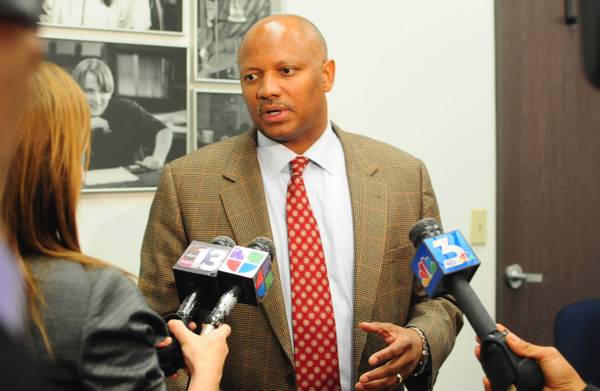Schools plan
KSNV coverage of Clark County schools superintendent plan to improve student achievement, May 26, 2011.
Related document
Sun coverage
Clark County Schools Superintendent Dwight Jones unveiled a blueprint for improving student achievement by providing more resources to low-performing schools and holding educators more accountable.
The 36-page plan outlines broad reforms, such as re-structuring school zones and establishing a new teacher evaluation system, and specifies goals and benchmarks for the district.
“I’m excited to finally get it out the door because we’ve been wanting to get a blueprint and I’ve been talking about it all over the city,” Jones said at Thursday’s School Board meeting. “We need to change. Our results are not what we want. I think this is the first step to realize good results.”
The report advocates for a fundamental shift in thinking about the School District’s objective from merely improving graduation rates to preparing students so they are “ready by exit,” which means being able to succeed in post-graduation opportunities without the need for remediation.
Jones’ blueprint is modeled after the Nevada Growth Model of Achievement, which emphasizes growth — whether students are progressing over time — rather than proficiency, or merely passing a standard.
“The growth model is going to allow folks in a very transparent way to really be able to gauge how their schools are doing and compare it to other schools, not only across Clark County but across the state,” Jones said.
As part of the growth model, schools must meet specific objectives by June 2016, Jones said.
• The graduation rate will reach 75 percent. It is now 68 percent.
• College remediation rates will decline yearly.
• Gaps between different ethnic and racial groups in annual academic achievement will narrow by half.
• The percentage of students scoring a 3 or higher on Advanced Placement exams will increase yearly at each high school.
• The percentage of students admitted and succeeding at postsecondary institutions will increase yearly.
• On-level literacy assessment rates at grades 1, 3 and 5 will reach 80 percent.
• Eighth-grade proficiency in algebra will reach 80 percent.
Jones reiterated his support for the School District’s empowerment school model, a program that increases per-pupil funding and allows principals greater autonomy in exchange for more accountability.
There are 30 empowerment schools in the 350-school district. Jones said he hopes expand the program.
Jones also advocated restructuring four area service centers into a dozen or more “performance zones” with an average of 20 to 30 schools.
Lower-performing schools would be grouped together in sets of 20 or 22 schools. The schools would receive certain benefits, such as having the first opportunity to hire new talent or tap into professional development funds.
They would, however, be held more accountable with more oversight and less autonomy, Jones said.
“We’re going to take resources and realign them according to need, but your license to operate is not going to be forever,” Jones said. “That’s another pretty dramatic departure for this district. You cannot be in a school that fails for years after years after years.”
High-performing schools, meanwhile, will be grouped into zones of 26 to 28 schools with less oversight and more autonomy, Jones said.
“If you can, through getting results, get in a zone to where you are free to operate and make better decisions about people, time and resources, then folks will spend their dollars better,” Jones said. “There are too many directives that come out of central office that say you have to do this, you have to purchase this. We ought to say, start making those decisions at the building level.”
Jones’ plan also calls for greater utilization of technology to help students and teachers.
The School District might consider online courses for students. These courses would personalize learning for students, said Jones, who pointed to California’s Rocketship Schools, where a quarter of classes are taught online.
“Technology is the wave of the future,” he said. “It’s time for Clark County to get on that wave.”
Teachers could also benefit from an existing repository of online resources, Jones said.
Under the blueprint, the district will establish a “Teacher’s Wikipedia” or an “Educator’s YouTube” consisting of an online database of curricula and teaching videos from high-performing educators to be shared among all teachers.
Initial reaction from school board members and teachers was largely positive. The School Board is expected to discuss the blueprint in depth during its next meeting on June 7.
School Board President Carolyn Edwards said she was “100 percent” behind the superintendent.
“This is the beginning of the work that needs to be done,” she said.
Although Jones insisted many of the reforms could be achieved with existing resources, the plan comes one week after the School Board approved a tentative budget for fiscal 2012 that would bridge a $407 million shortfall by laying off at least 5 percent of the workforce.
“There has to be conversations with unions when it comes to these kinds of innovations,” Clark County Education Association President Ruben Murillo said. “Some of these we’re going to work with (Jones) to implement. Others, we’re going to have to have serious conversations, because of the ramifications on our teachers in terms of salary and benefits.”
Overcoming the budget cuts — $794.5 million since the 2008-2009 academic year — to implement the plan will be difficult, Jones said.
“People would say, ‘He must have his head in the sand,’ if I didn’t say it was a challenge,” he said. “Ultimately, we’re failing far too many kids in this School District. We’ve got to come up with a better way to get better results, so the plan has to go forward.”


Join the Discussion:
Check this out for a full explanation of our conversion to the LiveFyre commenting system and instructions on how to sign up for an account.
Full comments policy